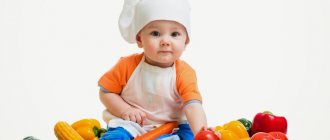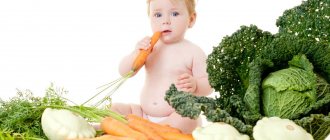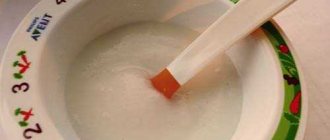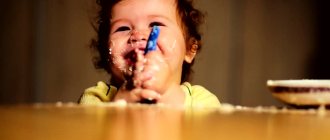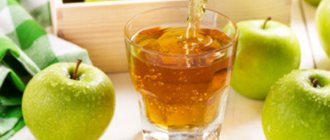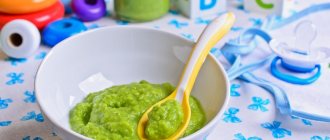The demand for food in a baby who is 6 months old increases literally before our eyes. Toddlers who are breastfed are already receiving their first complementary foods, while artificial ones have even managed to get used to it and need more variety. In the first case, there is no extreme need to track how much and what the baby needs; he should still receive the main components from mother's milk.
In the second, you will have to try a lot to ensure that the child is provided with everything necessary and at the same time does not suffer from colic, gas, regurgitation and other unpleasant consequences of an improperly organized food intake process.
Diet
A six-month-old infant is already quite active, so the main changes in the regime during this period are associated with changes in the diet. The baby already needs more energy to master new skills, so at the beginning of the seventh month of life the baby begins to get acquainted with new taste characteristics of dishes and products.
Breastfed
Breastfed children up to this age usually eat only breast milk, as it contains all the beneficial and nutritious elements necessary for growth, development of the brain and visual system, as well as strengthening the child's immunity. Until the beginning of the seventh month of life, experts from the World Health Organization (WHO) do not even recommend feeding children whose diet consists exclusively of breast milk, because milk consists of almost 88% water.
On artificial or mixed feeding
Children receiving adapted breast milk substitutes or who are on a mixed type of feeding try their first complementary foods much earlier - at 4-5 months. Therefore, by the age of six months, their diet usually consists not only of formula milk, but also of milk and non-dairy cereals, fruit and vegetable purees, juices and fermented milk products, adapted to the age needs of the child.
How much breast milk or formula should a six month old baby eat?
| Type of feeding | Amount of milk or formula per feeding | Daily intake of milk or formula |
| Breast-feeding | 150-180 ml | 900 ml |
| Artificial feeding | 180-210 ml | 900-1000 ml |
| Mixed feeding | 100-180 ml | 800-950 ml |
Important! The main product for feeding a child should remain mother's milk or its substitute. Even if the baby eats the offered complementary foods well and has no signs of allergies, you should not rush and increase the amount of other products in the children's menu.
Sample menu for a breastfed or bottle-fed baby
First feeding: 180 ml of breast milk or breast milk substitute
Second feeding: 150 g of porridge with added fruit, supplemented with milk.
Third feeding: 50 g of fruit puree, 30 ml of fruit juice, cookies, supplementary feeding with milk.
Fourth feeding: 120 g of vegetable puree with the addition of yolk. 30 g meat puree, supplementary feeding.
Fifth feeding: 190-200 ml of breast milk or formula.
During sleep, no more than 1 feeding with milk or formula is allowed.
Introduction of complementary feeding: WHO recommendations
It is recommended to introduce complementary foods to infants from the age of six months. Readiness to get acquainted with new food products is indicated by special signs, which include:
- the child’s ability to sit with a straight back (including sitting with support for the back);
- signs of food interest (trying to grab a spoon during dinner for adults, closely monitoring the actions of other family members during meals, reaching for food from the common table);
- shortening the interval between feedings (indicates that the infant does not have enough milk and quickly feels hungry).
It is necessary to start introducing any new foods and drinks with one teaspoon. Soviet pediatricians recommended introducing complementary foods at the third or fourth feeding (usually an afternoon snack), but now WHO experts advise introducing new foods at morning or afternoon feedings so that the baby’s condition can be monitored throughout the day and, in case of allergies or poor tolerance, provide him with the necessary help.
Introducing new dishes into the diet is quite a stressful situation for a baby, especially if before that he only knew the taste of mother's milk. To make the process of getting to know new tastes painless, you need to introduce complementary foods correctly.
Advice from pediatricians and WHO experts
- You should not add salt and sugar to food in order to improve the taste of dishes and speed up the adaptation to new food. This can lead to the child later refusing to eat unsweetened or unsalted foods, and these supplements are completely unnecessary in the first year of a child’s life.
- It is better to choose a spoon for the first feeding from silicone - it is easy to clean and does not injure the baby’s gums.
- Complementary foods should be given as a first course, supplementing the baby with formula or milk.
- You cannot introduce complementary foods if the child is sick, feels unwell, is teething, or is simply not in the mood.
Important! Recently it was believed that the ideal product for first feeding is green apple puree. Now pediatricians recommend giving your baby vegetable dishes first, gradually adding cereals and fruits to the diet in order to avoid excessive addiction to sweet foods in the future.
What can you give your 6 month old baby to eat and drink?
By the end of the seventh month, porridge, juices and fruit and vegetable purees should be introduced into the children's diet. Porridges can be dairy or dairy-free. Buckwheat, oatmeal, corn and rice porridges are best digested at this age, but products with added rice should not be included in the menu of children prone to constipation (this also applies to banana puree). You can add some grated apples, peach or pear puree to the porridge. If well tolerated, adding 3-5 ml of cream is allowed.
Of the fruit and vegetable purees, the first to be introduced are apples, zucchini, potatoes, and pears. After a few weeks, you can introduce the baby to carrots, pumpkin, bell peppers, apricots, prunes and bananas. You can add a little vegetable oil to vegetable puree.
If your baby has already received complementary foods in the form of fruit and vegetable juices and purees before six months, you can offer him pureed beef, chicken or veal. Meat products can be mixed with cereals or vegetables or served as a separate dish.
Important! The last thing to be introduced into the diet of a six-month-old baby is boiled chicken yolk (about a quarter of the yolk per day).
Diet
| Products | How much should a baby eat by the end of the seventh month of life? |
| Fruit juice | 60 ml |
| Fruit puree | 50-60 g |
| Children's cottage cheese | 40 g |
| Porridge with milk | 150 g |
| Vegetable puree (homemade greens may be added) | 120-140 g |
| Baby instant cookies (can be given from 5 months) | 3-5 g |
| Vegetable oil | 2-3 g |
| Meat puree | 40-50 g |
| Butter 82.5% fat | 3-4 g |
How to calculate the daily amount of breast milk according to Maslov
Soviet pediatrician Maslov developed a caloric method for determining the amount of milk needed by a newborn baby. To make the correct calculation, you need to know the exact weight of the baby. A liter of breast milk contains about 700 kilocalories. One kilogram of a child’s body weight per day needs the following amount of energy:
- up to three months of life – 125 kcal;
- from three to six months – 120 kcal;
- from six to nine months – 110 kcal;
- from nine months to one year – 100 kcal.
To calculate the daily portion of milk, you need to multiply the number of kilocalories by the baby's weight. For example, a two-month-old baby weighs 6 kg. It turns out: 125 kcal × 6 kg = 750 kcal. In this case, the child needs to consume a little more than half a liter of breast milk per day.
How long should a baby sleep at six months?
A child’s daily routine at 6 months changes in accordance with the characteristics of his development and physiological needs. The amount of daytime sleep is reduced. During this period, many children switch to a one-time three-hour nap during the day, but most babies continue to sleep twice a day for 1.5-2 hours . The duration of night sleep is about 10-11 hours with a break for one night feeding. If a child wakes up more often, it is necessary to find out the reason, since healthy children at this age do not need more frequent and abundant night feedings.
The reasons for poor sleep in a six-month-old child may be:
- violation of the diet and feeding schedule, as a result of which the child does not receive enough food during the day and feels hungry at night;
- too hot or very cold air in the room (the optimal temperature for healthy sleep is +18 degrees);
- uncomfortable sleepwear, poor-quality bed linen, use of too aggressive detergents for washing children's clothes.
Poor sleep can also be the result of an incorrect daily routine. For example, if your baby is put to bed too late for his second nap, he will stay awake for a long time after his evening bath. Lack of activity can also lead to difficulty falling asleep or waking up frequently at night, so a daily routine at this age is a must for all children.
Artificial feeding, and the norm in quantity
So, as we have already figured out, the amount a child eats depends on the physiology of the child himself. But for bottle-fed babies, the requirements for the norm and volume of food consumed will be slightly different from the requirements for infants. Also, diet is very important for artificial babies. Breast milk is digested much faster, and the mother can, as is now practiced, attach the baby to the breast more often. And the mixture takes longer to digest, so the break time between feedings is very important, and accordingly the serving size.
But the amount that a child should eat should not be determined by the labels on the package or can of food. Only an individual calculation, which is taken in relation to the age and body weight of the newborn.
There are a lot of ways to do the calculation. Here are a few to help you do it right
How to calculate a portion of formula or milk for one time.
- We multiply the baby’s age in days “N” by ten and get the amount that he should eat at one time of formula/milk “X”; N*10=X
- The next method says that weight “g” / height “cm” = number of servings at a time. What should be the amount of food consumed per day?
- Let's start with weight. For children weighing more than 3kg.200g, the calculation will be as follows: N*80=X; and for babies weighing less than 3kg.200g. N*70=X; N is the age of the baby in days, X is the volume of the portion eaten.
- Already from two months, 800g. Eating a day is considered the norm. For all subsequent months we add 50 ml. As a result, by eight months the baby can eat about 1110 ml.
Of course, there are a lot of ways, but again, each child has his own approach. Since for children with the same weight, height and age, the norm may not be at all what the numbers say.
If everything is fine with the baby, he is active, nothing bothers him, the baby sleeps sweetly and plays, do not panic if he takes 250 ml instead of the prescribed amount. eats 200 ml. Pay attention to how he behaves and give him a smaller portion. It is approximately normal if the baby gains weight from 150g to 200g per week.
Further. There is a very interesting way to check whether your child is getting enough nutrition. Of course, you will have to go without diapers for a day, and, of course, change the diaper after every bowel movement. So, after twenty-four hours, dirty diapers, there should be at least twelve.
Control weighing. If for a baby, you need to determine how much he eats at a time. It can be weighed before feeding and after. Just without changing clothes. The difference in the volume of a portion eaten at a time will differ from the portion eaten by an artificial person. Especially if the baby is fed on demand, without adhering to a specific schedule. In contrast, a formula-fed baby is fed according to time. The difference in feeding frequency can be twofold. For accurate conclusions, weighing should be carried out over several days.
Care and walks
Starting from the seventh month of life, the child’s daily routine changes significantly, not only in terms of feedings and periods of wakefulness - changes also apply to walks, as well as hygiene care.
Walks. If previously the baby mostly slept during walks, now it is better to have at least one nap during the day at home. On the street, the baby will look with interest at the objects and people around him, which has a positive effect on the development of the visual organs, attention and general intellectual development. If the mother allows the baby to pick up leaves, touch pebbles or sand on the river bank, this also helps to improve tactile perception and develop fine motor skills. The duration of stay on the street for 6 months is no different from previous periods and is about 4 hours a day, which must be divided into two walks.
Bathing. You can bathe a six-month-old baby once every 2-3 days. For children with problem skin, frequent diaper rash and skin rashes, you can add a decoction of string or chamomile to the bathing water. Calendula has good anti-inflammatory and cleansing properties, but it causes allergies more often than other plants. The duration of water procedures is at least 10-12 minutes. If you are moody or have difficulty falling asleep, you can add pine needle extract to the water (not to be confused with the concentrate!).
Massage and gymnastics should be age appropriate. The massage techniques and technique should be shown by the local nurse.
By following simple rules and tips for organizing a child’s daily routine and nutrition at 6 months, you can significantly improve his physical and psycho-emotional development. The regime is necessary not only for developing healthy habits and organizing the mother’s time, but also for the child’s health, which at this age completely depends on the actions of the adults caring for the baby.
Educational activities and games
To develop a child, you need to work with him. In this paragraph we will talk about different educational games that can be used.
General useful games and activities.
Child exploring the house
If the little one already knows how to move independently, then he will definitely start climbing around the house. To protect your baby from any troubles, block off the approaches to the stairs, be sure to lock the door to the bathroom, and secure any electrical outlets. You also need to make sure that it cannot catch on sharp corners; also lock the drawers in the closet. It is important not to miss anything, because any mistake can have serious consequences. We pay special attention to medications, toxic substances and detergents. They must be safely hidden!
On the floor with the child
It is important for a child to have enough space to play. To do this, you need to let him sit on the floor. This way he can learn to crawl and roll over. If the baby does not like to be alone, then his parents should play with him.
Also at six months of age, an interest in small boxes and small things appears. There is no need to put all the toys in one large box; it is better to divide them into several small boxes. This will add fun for the child.
Invite friends over
It can also be an interesting moment when a baby comes to visit and can play with yours. After children explore each other, they will understand that there are very large differences between living people and toys.
Next we will describe exercises that are associated with new discoveries for the child.
Conversation with a cup
For this exercise you need to assemble three different cup shapes and sizes. We put them in a cardboard box. After the cup is brought to the child’s mouth, repeat some familiar word, for example, his name. This must be done with different intonations. This way the baby will understand that his name can sound different. Subsequently, you need to pronounce a wide variety of sounds, since in this case the child will most likely begin to repeat them.
Balloon with water
Take a balloon and fill it with water, but only a little, and tie a ribbon to it. After this, you need to squeeze and swing the ball and show the baby that the shape of the ball can change. Let your child do the same manipulations. During the game, he will understand that the ball bounces if you throw it, and if you spin it, it swings. But during these games you cannot leave the little one on his own; he will definitely want to try the ball on his teeth. And this can cause harm.
Playing with sounds
Your child will definitely love this game with sounds. Take plastic bottles and pour different amounts of water into them. When you hit them they will make different sounds. The child will definitely notice the difference and join the game.
Photos of mom and dad
It will be useful for parents to say the words “mom” and “dad” often. It would also be good to attach photographs of the parents above the child’s bed or chair. When the baby tries to say “pa-pa” or “ma-ma,” parents should show photographs and say where mom is and where dad is.
